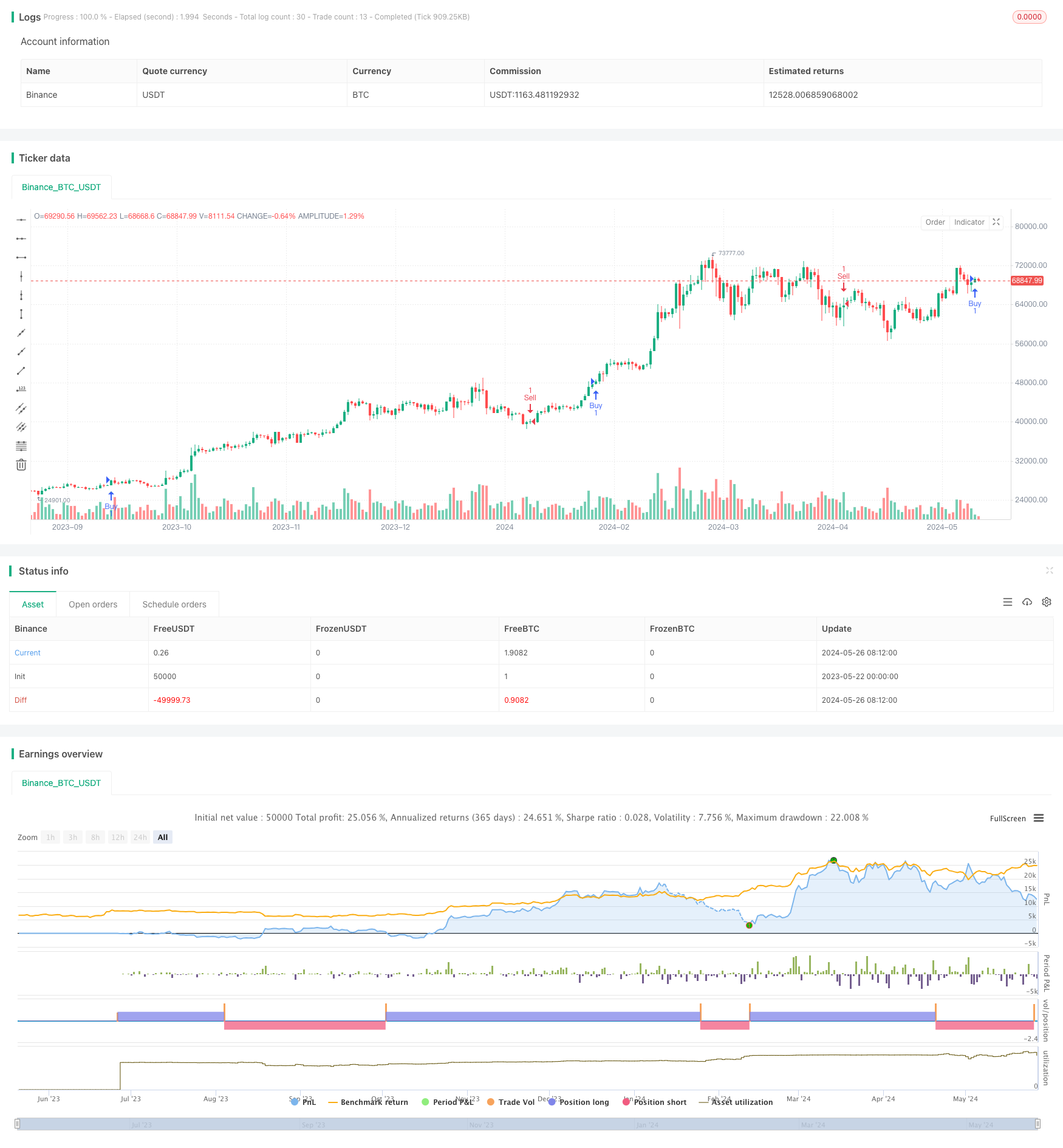MA,SMA Dual Moving Average Crossover Strategy
Author: ChaoZhang, Date: 2024-05-28 10:53:02Tags: MASMA

Overview
This strategy uses two moving averages (MAs) with different periods to generate trading signals. When the short-term MA crosses above the long-term MA from below, it generates a buy signal; when the short-term MA crosses below the long-term MA from above, it generates a sell signal. The main idea behind this strategy is to utilize the trend-tracking characteristics of MAs and capture trend changes through MA crossovers for trading purposes.
Strategy Principle
- Calculate two moving averages (MAs) with different periods: a short-term MA and a long-term MA.
- When the short-term MA crosses above the long-term MA from below, it indicates a potential uptrend formation and generates a buy signal.
- When the short-term MA crosses below the long-term MA from above, it indicates a potential downtrend formation and generates a sell signal.
- Trade based on the buy and sell signals: open a long position when a buy signal appears, and open a short position when a sell signal appears.
Strategy Advantages
- Simplicity: The strategy logic is clear, easy to understand, and implement.
- Trend tracking: By capturing trend changes through MA crossovers, the strategy can adapt well to different market trends.
- Parameter flexibility: The period parameters of the short-term and long-term MAs can be adjusted based on different markets and time frames to optimize strategy performance.
Strategy Risks
- Choppy markets: In choppy markets, frequent MA crossovers may lead to many false signals, resulting in more losing trades.
- Trend lag: MAs are lagging indicators, so the strategy may miss some profits at the beginning of a trend change.
- Parameter optimization: Different parameter settings can significantly affect strategy performance, and parameter optimization requires a large amount of historical data and computational resources.
Strategy Optimization Directions
- Add trend filters: After an MA crossover generates a signal, other trend indicators (such as MACD, DMI, etc.) can be used for secondary confirmation to filter out some false signals.
- Optimize take profit and stop loss: Reasonably setting take profit and stop loss levels can minimize losses and let profits run in case of trend delays.
- Dynamic parameter optimization: Dynamically adjust MA period parameters based on different market conditions to adapt to current market characteristics.
- Combine with other signals: Combine MA crossover signals with other technical indicators (such as RSI, Bollinger Bands, etc.) to form more reliable trading signals.
Summary
The dual moving average crossover strategy is a simple and easy-to-use trend-tracking strategy that captures trend changes through the crossover of two MAs with different periods. The strategy’s advantages are clear logic, explicit signals, and suitability for trending markets. However, in choppy markets, the strategy may generate more false signals and losing trades. Therefore, in practical applications, the strategy’s performance can be improved by adding trend filters, optimizing take profit and stop loss, dynamically optimizing parameters, and combining with other signals to enhance its adaptability and stability.
/*backtest
start: 2023-05-22 00:00:00
end: 2024-05-27 00:00:00
period: 1d
basePeriod: 1h
exchanges: [{"eid":"Binance","currency":"BTC_USDT"}]
*/
//@version=5
strategy("Combined Strategy", overlay=true)
// Moving Averages Length Inputs
short_length = input.int(20, "Short MA Length")
long_length = input.int(50, "Long MA Length")
// Moving Averages
ma_short = ta.sma(close, short_length)
ma_long = ta.sma(close, long_length)
// Buy Condition (Moving Average Crossover)
buy_condition = ta.crossover(ma_short, ma_long)
plotshape(series=buy_condition, style=shape.triangleup, location=location.belowbar, color=color.green, size=size.small)
// Sell Condition (Moving Average Crossover)
sell_condition = ta.crossunder(ma_short, ma_long)
plotshape(series=sell_condition, style=shape.triangledown, location=location.abovebar, color=color.red, size=size.small)
// Strategy Entry and Exit
if (buy_condition)
strategy.entry("Buy", strategy.long)
if (sell_condition)
strategy.entry("Sell", strategy.short)
// Debug statements
if (buy_condition)
label.new(x=bar_index, y=low, text="Buy Signal", color=color.green, style=label.style_label_up)
if (sell_condition)
label.new(x=bar_index, y=high, text="Sell Signal", color=color.red, style=label.style_label_down)
- MA, SMA, MA Slope, Trailing Stop Loss, Re-Entry
- Dynamic Position Dual Moving Average Crossover Strategy
- Moving Average Crossover Strategy
- SMA Dual Moving Average Trading Strategy
- MA Cross Strategy
- Multi-Moving Average Trend Trading Strategy
- Trend Catcher Strategy
- Dual Moving Average Crossover Adaptive Parameter Trading Strategy
- Moving Average Crossover Strategy Based on Dual Moving Averages
- Dual Moving Average Momentum Trading Strategy: Time-Optimized Trend Following System
- Multiple Moving Average and Stochastic Oscillator Crossover Quantitative Strategy
- Fibonacci Golden Harmony Breakout Strategy
- Dynamic Market Regime Identification Strategy Based on Linear Regression Slope
- Trend Reversal Trading Strategy Based on RSI Divergence
- Dual Moving Average RSI Momentum Strategy Based on EMA and Trendline Breakouts
- Dynamic Position Management Daily Trading Strategy
- Technical Trading Strategy for BTC 15-minute Chart
- Dynamic Position Sizing Short-Term Forex Trading Strategy
- Advanced 15-Minute Chart Trading Signal Strategy
- PSAR and EMA-Based Quantitative Trading Strategy
- Standard Deviation DEV Trading Strategy Based on Relative Strength Index RSI and Simple Moving Average SMA
- Risk-Reward Ratio and Technical Analysis Based Bull Flag Breakout Strategy
- Multi-factor Fusion Strategy
- Bollinger Bands + RSI + Multi-MA Trend Strategy
- QQE and RSI-based Long-Short Signal Strategy
- Zero Lag MACD Dual Crossover Trading Strategy - High-Frequency Trading Based on Short-Term Trend Capture
- Trend Following Average True Range Trailing Stop Strategy
- SMC & EMA Strategy with P&L Projections
- Nadaraya-Watson Envelope Multi-Confirmation Dynamic Stop-Loss Strategy
- Dynamic Take Profit Bollinger Bands Strategy
- CCI + MA Crossover Pullback Buy Strategy